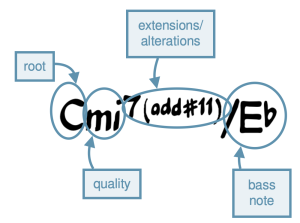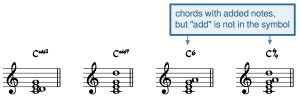VI. Jazz
Chord Symbols
Megan Lavengood
Key Takeaways
- Chord symbols tell you the root of the triad, the quality of the triad, any extensions to the triad, and any non-root bass note.
- Chord symbols don’t reference a specific key. Instead, symbols are always assumed to be a certain quality unless otherwise indicated:
- Triads are assumed to be major.
- Sevenths added to the triad are assumed to be minor.
- All other extensions and added tones are assumed to be major/perfect.
- Alterations are shown through sharp and flat symbols, or through plus and minus symbols. Both systems are prevalent in the real world; when writing your own charts, pick one system and stick with it consistently. This textbook will use the sharp/flat system of showing alterations.

There are two systems of shorthand for discussing harmony used in this textbook: chord symbols and Roman numerals. Chord symbols are also sometimes called “lead sheet symbols” because you will find them on lead sheets, which are jazz scores that typically notate only a melody and these chord symbols.
Chord symbols can pack a lot of information into a few letters. A complex symbol is given in Example 1, with annotations to show the various possible components of a chord symbol.
Basics of Chord Symbols
Triads
Chord symbols are based on the major triad as the norm. If you see nothing but a note name as a chord symbol, this means to play a major triad. Other symbols are added to indicate other triad qualities, as summarized in Example 2.
[table id=16 /]
Example 2. Chord symbols for triads.
Notice that there are several ways to represent each non-major triad quality. This is because chord symbols were created along the way as jazz developed and were never completely standardized. The symbols in Examples 2 and 3 are not comprehensive, but you can likely decode other variations based on the ones here. It’s good to be aware of all the possible ways of representing these different triad qualities, but stick to one method for yourself. In Examples 2 and 3, the symbols used in this textbook are given first.
Seventh chords
The most common addition to a triad is the interval of a seventh. An added seventh is indicated with the Arabic number 7 written after the root, superscript.
As with the triad, the numeral 7 by itself indicates a default quality: a minor seventh. Alterations to the symbol indicate other possibilities, resulting in the seventh-chord symbols summarized in Example 3:
[table id=17 /]
This table only shows the five traditional seventh-chord qualities, but others are possible, such as m(maj7), aug7, and more. Again, these tables are not comprehensive, but when you encounter an unfamiliar symbol, you should be able to use your knowledge of basic symbols to figure out what it means.
Bass notes
In much of jazz and pop, the bass note is the root of the chord. (Bassists may improvise around other notes, rather than strictly staying on the root of the chord, but this wouldn’t affect how the harmony is written down.) For this reason, chord symbols are assumed to indicate root position chords unless otherwise indicated.
If the bass note should be something other than the root, this is shown with a slash followed by the letter name of the bass note. For example, C/E means to play a C major triad with an E in the bass.
Significantly, the bass note does not need to be a member of the chord! C/F♯ would indicate to play a C major triad over an F♯.
Extensions

Jazz harmony often involves not only playing the notes explicitly indicated by the chord symbol, but also adding upper extensions. The term extension comes from the idea of extending the stack of thirds that creates harmonies. The seventh is the most common triadic extension, but jazz often makes use of higher extensions—stacking more and more thirds onto the basic triad results in the ninth, eleventh, and thirteenth (Example 4).
Interval size
You may notice that ninths, elevenths, and thirteenths are just compound versions of seconds, fourths, and sixth, respectively, so why use the more difficult-to-conceptualize compound intervals, instead of just calling these intervals seconds/fourths/sixths? There are two reasons:
- The presence of an extension in a chord symbol implies the presence of all other extensions below it as well. So, an eleventh chord is not just a triad plus the eleventh—it’s a triad plus an eleventh, ninth, and seventh.[1]
- Extensions are often voiced (played) above the other chord members. In other words, in actual performed music, the extension really sounds a thirteenth above the root, not a sixth (for example).
Interval quality and alterations to extensions
While the default quality of the seventh is minor, extensions and additions are assumed to be major (ninths and thirteenths) or perfect (elevenths) unless otherwise indicated. The chord in Example 4, then, is simply a C13 chord: all the extensions are major/perfect intervals above C, except the seventh (B♭), which is minor.
Other interval qualities are shown with sharp and flat symbols that raise or lower the default pitch by a half step. So, a C7(♯11) chord would include an F♯ above the root—an augmented eleventh—instead of the typical F♮.

Note that in this context, these symbols are to be interpreted relatively. So, ♯11 really means “raise the eleventh” and ♭9 really means “lower the ninth”—as Example 5 shows, the altered note will not necessarily be a sharp or flat pitch.. This is discussed more below under “Chord Symbols vs. Roman Numerals.”
For clarity, always write “7” before listing altered extensions. Furthermore, altered extensions often placed in parentheses, so that a performer can easily see that the accidental is to be applied to the extension, not to the root of the chord. If multiple altered extensions are used, slashes might also be used to clearly delineate the alterations, as shown in Example 5.
Added Notes (add) and Suspensions (sus)
add

To indicate that a note is added to a chord without implying a seventh underneath, the word “add” is written into the symbol. Cadd9, for example, is a C-major triad with a D voiced above the triad, but without any seventh: C–E–G–D. (Recall that C9 otherwise implies a minor seventh added to the C triad as well: C–E–G–B♭–D.) You can also add notes within a triad: Cadd2 indicates a C-major triad with an additional D that is voiced inside the triad: C–D–E–G.
In the case of an added sixth, we simply use the numeral 6 without “add”—for example, a C major triad with an added sixth is written as C6. There are two reasons why this is acceptable (and normal) shorthand: one, the added sixth is especially common, and two, there is no possible interpretation that one might confuse it with. Another common addition to triads is the sixth and ninth together, which is also indicated without the word “add”: for example, C[latex]^6_9[/latex].
sus

Another alteration is the suspended chord, abbreviated “sus,” which indicates that the third of the chord should be replaced with another interval above the root (Example 6). The term comes from a common type of suspension, in which the fourth above the bass resolves to the third above the bass. Indeed, a sus chord will often be followed by a non-sus chord with the same root (though this is not required by any means).
The default assumption is that the third of the chord is replaced with a perfect fourth above the root. Csus, then, would yield the notes C–F–G—the E of the C triad is replaced with F.
Occasionally, you may see a sus2 chord, which replaces the third with the major second above the root (Csus2 = C–D–G).
To write the symbol for a seventh/extended chord with a suspension, the “sus” abbreviation comes after the extension, as in C7sus. This is for clarity’s sake, since Csus7 might look too much like Csus2.
Try it!
Check and see if you understand chord symbols by taking out a sheet of scrap paper and notating the harmonies indicated by the chord symbols below. As you complete each chord, you can pull the slider to the right to reveal the correct answer.
You can also view and listen to the answer on Musescore.com.
Chord Symbols vs. Roman Numerals
It’s important to understand that chord symbols are absolute labels, while Roman numerals are relative labels. Roman numerals are more theoretical and abstract, because they tell you the location of a chord relative to the key of the piece. Chord symbols, on the other hand, tell you exactly (absolutely) which notes are being played in this given chord, without reference to any key. It’s important to leave the relative thinking behind temporarily when you interpret chord symbols. Chord symbols do not reference keys.

Chord symbols are not analytical—they’re a shorthand way of writing a score. In other words, the purpose of chord symbols is to get performers’ fingers to the right notes at the right time. Chord symbols may represent things in a less functional sense if it means the symbol is easier to interpret. Example 7 is one such case: although the second chord really functions as an A♭7(#5) chord, neighboring to the regular A♭ triad, the symbol C/A♭ is probably easier to process and thus preferred. (However, neither symbol is inherently right or wrong all the time—both will result in the right notes being played, and the better choice depends on context.)
Keeping these issues in mind helps in understanding the logic present in the system of chord symbols. Even though there is a lot of variation in chord symbols, learning a few rules will help you decipher any symbol.
- Chord symbols basics worksheet (.pdf, .mscz). Asks students to identify and write triads and seventh chords with chord symbols.
- Chord symbols with extensions (.pdf, .mscz). Asks students to identify and write extended chords with chord symbols.
Media Attributions
- Extensions
- Altered extensions
- Added notes
- Sus chords
- Less confusing
- Although all the extensions below the highest extension are implied, they are not necessarily played. In fact, usually all the possible notes are not played, and some of the extensions between the highest and the seventh are omitted. The differences between what is notated, what is understood, and what is actually played are discussed more in the chapter on Jazz Voicings. ↵
The lowest note of a triad or seventh chord when the chord is stacked in thirds.
The lowest part (or "voice") of a composition.
A system of naming chords that specifies the note name of the root, chord quality, and any alterations.
Some basic symbols are given below as a quick reference, but for more detail, see the Chord Symbols chapter.
[table id=67 /]
A type of jazz/pop score that typically notates only the melody and the chord symbols (written above the staff).
A triad whose third is major and fifth is perfect.
A term that summarizes the quality of the third, fifth, and seventh (if applicable) above the root of the chord. Common chord qualities are major, minor, diminished, half-diminished, dominant, and augmented.
In typesetting, superscript characters appear higher on the page than the regular characters—like an exponent in math. For example, in the chord symbol C⁷, the 7 is superscript.
Ordering the notes of a chord so that it is entirely stacked in thirds. The root of the chord is on the bottom.
Adding additional thirds on top of the triad. Most commonly refers to ninths, elevenths, or thirteenths rather than sevenths, although sevenths are also extensions.
An interval that is larger than an octave.
A term that indicates the exact number of semitones between two pitches in an interval (compare with interval size, which indicates only the number of letters between two pitches). Common interval qualities are major, minor, perfect, augmented, and diminished.
Considered in relation to some other system. For example, modes are said to be relative if their scales share all the same notes (like C major and A minor).
Existing on its own, without reference to another system. For example, "absolute pitch" refers to the phenomenon of being able to sing a pitch without referencing an instrument or another pitch.

